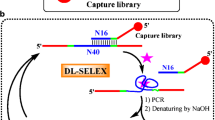Abstract
Aptamers are ssDNA or RNA oligonucleotides with very high affinity for their target. They bind to the target with high selectivity and specificity because of their specific three-dimensional shape. They are developed by the so-called Systematic Evolution of Ligands by Exponential Enrichment (SELEX) process. We have modified this method in two steps—use of fluorescent labels for DNA quantification and use of magnetic beads for target immobilization. Thus, radioactive labelling is avoided. Immobilization on magnetic beads enables easy handling, use of very small amounts of target for the aptamer selection, rapid and efficient separation of bound and unbound molecules, and stringent washing steps. We have called this modified SELEX technology FluMag-SELEX. With FluMag-SELEX we have provided a methodological background for our objective of being able to select DNA aptamers for targets with very different properties and size. These aptamers will be applied as new biosensor receptors. In this work selection of streptavidin-specific aptamers by FluMag-SELEX is described. The streptavidin-specific aptamers will be used to check the surface occupancy of streptavidin-coated magnetic beads with biotinylated molecules after immobilization procedures.







Similar content being viewed by others
References
Tuerk C, Gold L (1990) Science 249:505–510
Ellington AD, Szostak JW (1990) Nature 346:818–822
Sun S (2000) Curr Opin Mol Ther 23:100–105
O’Sullivan CK (2002) Anal Bioanal Chem 372:44–48
Tombelli S, Minnuni M, Mascini M (2005) Biosens Bioelectron 20:2424–2434
Luzi E, Minunni M, Tombelli S, Mascini M (2003) TrAC—Trends Anal Chem 22:810–818
Clark SL, Remcho VT (2002) Electrophoresis 23:1335–1340
Deng Q, German I, Buchanan D, Kennedy RT (2001) Anal Chem 73:5415–5421
German I (1998) Anal Chem 70:4540–4545
Davis KA, Abrams B, Lin Y, Jayasena (1996) Nucleic Acids Res 24:702–706
Potyrailo RA, Conrad RC, Ellington AD, Hieftje GM (1998) Anal Chem 70:3419–3425
Liss M, Petersen B, Wolf H, Prohaska E (2002) Anal Chem 74:4488–4495
Ulrich H, Martins AHB, Pesquero JB (2004) Cytometry 59A:220–231
Brody EN, Gold L (2000) Rev Mol Biotechnol 74:5–13
Crameri A, Stemmer WP (1993) Nucleic Acids Res 21:4410
Williams KP, Bartel DP (1995) Nucleic Acids Res 23:4220–4221
Zuker M (2003) Nucleic Acids Res 31:3406–3415
http://www.bioinfo.rpi.edu/applications/mfold/
Srisawat C, Engelke DR (2002) Methods 26:156–161
Tahiri-Alaoui A, Frigotto L, Manville N, Ibrahim J, Romby P, James W (2002) Nucleic Acids Res 30:e45 (1–9)
Bittker JA, Le BV, Liu DR (2002) Nat Biotechnol 20:1024–1029
Acknowledgements
This work was supported by Sächsisches Staatsministerium für Umwelt und Landwirtschaft (Germany) within the Biotechnology Program (Project-No. 13-8811.61/93). We thank Nadia Nikolaus and Doerthe Mann for their kind assistance and critical reading of the manuscript.
Author information
Authors and Affiliations
Corresponding author
Rights and permissions
About this article
Cite this article
Stoltenburg, R., Reinemann, C. & Strehlitz, B. FluMag-SELEX as an advantageous method for DNA aptamer selection. Anal Bioanal Chem 383, 83–91 (2005). https://doi.org/10.1007/s00216-005-3388-9
Received:
Revised:
Accepted:
Published:
Issue Date:
DOI: https://doi.org/10.1007/s00216-005-3388-9




